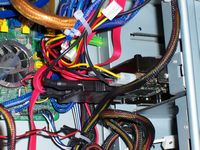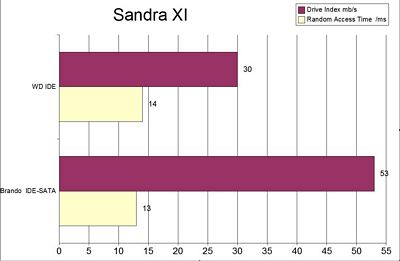Installation, Testing and Comparison
I’ll be honest, installation was a pain, there are no instructions on how to set the jumpers and the switch. There is a little diagram on the back of the device but it’s confusing, and I already showed you that the diagram on the bottom shows the same settings for either setup.
Since I didn’t have a clue really about how to go about this I tried setting the device to one of the settings, the one that ‘looked’ like it was for IDE to SATA, that didn’t work. So I thought maybe it had something to do with the jumpers on the hard drive itself, well the Western Digital IDE hard drive I used for this review has four different settings for the jumpers, so after numerous times of turning the computer off and on to change the jumpers it still wouldn’t work.
From the following picture and the one shown above you can see that the converter is actually fairly long and it does stick out far, this could be a problem in some cases.
So I switched the jumper and the switch to SATA to IDE and tried the process all over again, of course on the last jumper setting, ‘Cable Select’ it finally worked.
Ok, now to me, common sense would be to use the setting that says IDE to SATA, that’s what I’m doing right? Taking an IDE hard drive and essentially turning it into an SATA hard drive, apparently that’s not common sense over in China where the device is made because as you saw the setting I needed was SATA to IDE…
It would have been very nice to have instructions included with this device it would have saved me quite a bit of time and frustration trying to figure it out.
Well after getting it to work finally, I found that I could actually use the IDE drive as an SATA boot drive.. just a side note FYI…
Ok, we know that this device can take an IDE drive and basically turn it into an SATA drive, but does it add any performance over the IDE drive? I figured I’d run a couple tests and find out, I ran HD Tach RW from SimpliSoftware and SiSoft Sandra XI Physical Disks Benchmark to see how they compared.
Here’s the specs of the IDE hard drive:
Western Digital Caviar SE
Model:Wd1200JB
Size 120 GB
Spindle speed 7200 RPM
Buffer size 2 MB
Heads 6
Platters 3
Latency 4.2 ms
Average search time in reading 8.9 ms
Average search time in recording 10.9 ms
Average track-to-track search time 2.0 ms
Average ‘full stroke’ search time 21.0 ms
The first graph you’ll see is the results using HD Tach, I first tested the HDD while hooked up with a standard IDE cable and then with the Convertor from Brando WorkShop to essentially turn the HDD into an SATA hard drive.
Results Interpretation:
Lower Score is better for Random Access
Higher Score is better for Burst Speed, Sequential Read Speed and Average read.
As you can see from the graph we’ve got a large increase in speeds for Burst, Sequential and Average read. The Random Access is only a point better, but overall it’s a nice increase in performance over the IDE drive.
The next set of tests was using SiSoft Sandra XI Physical Disks Benchmark.
Results Interpretation:
Drive Index – Higher is better
Random Access Time – Lower is better
And here again we can see a huge increase in performance over the IDE interface, and again only a point better for the Random Access times…
Not bad, not bad at all… I’ll be keeping this in my system. I’ve got a micro-atx mobo that only has one IDE header, it’s hard to hook up an IDE hard drive and an optical drive, now I don’t have to worry about that.




